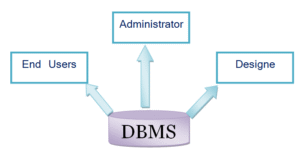Users of DBMS
A Database Management System (DBMS) serves different types of users who interact with the database based on their roles, technical knowledge, and purpose. These users range from technical developers to end-users with no programming experience. Understanding the types of DBMS users is important to see how database systems are utilized in real-world applications.
1. Database Administrators (DBAs)
- The Database Administrator is responsible for the overall management of the database system.
- Their duties include installing and configuring the DBMS, managing storage and users, creating backups, ensuring security, monitoring performance, and enforcing data integrity.
- DBAs also handle recovery operations in case of failure, and they define the structure of the database (schemas, tables, indexes).
2. Application Programmers / Developers
- These users write software applications that interact with the database.
- They use programming languages (like Java, Python, PHP, etc.) combined with SQL queries to create, retrieve, update, or delete data.
- Application developers build the logic for how data is processed, displayed, and stored in applications like web portals, mobile apps, and enterprise tools.
3. End Users
- End users are the people who directly use applications that access the DBMS but may not know how the database works internally.
- They can be classified further into:
-
Casual users: Occasionally run queries or reports (e.g., HR manager checking employee records).
-
Naïve users: Use predefined forms and applications (e.g., customers using an ATM or booking site).
-
Sophisticated users: Write complex queries or use analysis tools (e.g., data analysts, researchers).
-
- End users interact with databases through user-friendly interfaces, often unaware of the underlying SQL or architecture.
4. System Analysts
- These users act as intermediaries between business requirements and database design.
- They understand what kind of data is needed, how it should be structured, and how systems should interact with the DBMS.
- Their role involves analyzing business processes and helping design systems that meet user needs efficiently.
5. Data Scientists / Business Analysts
- These users perform data analysis, mining, and visualization using the information stored in databases.
- They write analytical queries, use data models, and often work with large volumes of data to generate insights and trends for decision-making.
- While not responsible for the database itself, they are heavy users of the data within it.
Conclusion
The users of a DBMS come from various backgrounds, each interacting with the database in different ways. From administrators managing system performance to end-users accessing data through applications, a well-structured DBMS supports a wide range of users simultaneously, ensuring efficient and secure data management.
